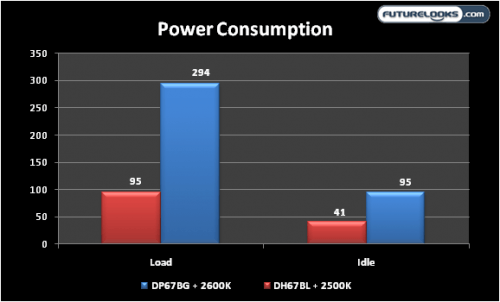RightMarkAudio Integrated Codec Test Results
Intel tends to do a reasonable job with integrated audio. Their solutions are typically free of excessive noise and distortion. Just to be sure, I tested both motherboards’ Realtek ALC892 codecs. Both scored identically so I’m only including the results from DH67BL Media board so that we don’t take up too much room:
 24-bit 48Hz
24-bit 48Hz
 24-bit 96Hz
24-bit 96Hz
 24-bit 192Hz
24-bit 192Hz
As you can see, general performance is good. In some ways, both reference boards scored very good. The end result on both platforms was great clarity and good quality playback in analog mode.
Power Consumption

Pairing up the boards and chips, we saw a similar pattern of power consumption. For the DP67BG, you can blame the GTX 460 which is needed for video as the board doesn’t provide a video out port like the DH67BL. Still, the Media board consumes very little thanks to Sandy Bridge’s new architecture.
Sandy Bridge Can Overclock!
What was probably (inaccurately) leaked was that the CPU Bus Clock just doesn’t scale as high like Lynnfield or Bloomfield. But, that doesn’t mean the core can’t be overclocked. A little different technique must be mastered in regards to the CPU bus and multiplier. After applying very little patience to start, reaching the 4GHz region was as easy as enabling Intel Turbo Tech and increasing the CPU bus just a bit.
However, after switching over to the MSI P67A-GD65 motherboard, I was able to verify that if you go off reservation via the BIOS, my K SKU chips were very close to 5GHz just I had seen on ASUS’ P8P67 EVO motherboard. One thing to keep in mind is that Turbo can cause the clocks to spiral out of control. Even though you may only be operating at 4.2GHz, Turbo will try and boost on top of that which can become unstable. We’ll cover more overclocking later we’ll be launching our Intel P67 motherboard round up very soon.
Final Thoughts
There’s so many good things about Sandy Bridge, I scarcely know where to begin. First off, it’s a new processor architecture that offers valuable performance enhancements that even the average user will enjoy. This includes the new Intel Turbo Technology 2.0, the HD 3000 IGP and Intel Quick Sync. Sandy Bridge does a good job of using the IGP for boosting media performance as well as actually making some game titles playable even at 720p. It’s not hardcore gamer impressive, but it’s definitely much better than previous generations and should satisfy most casual gamers. The great thing is that these features are available in both desktop and mobile processors.
The bottom line here is that Sandy Bridge is worth the upgrade if you’re sitting there on a Core 2 based system. Performance is great, power consumption continues to drop especially if you’re on a laptop, and fully featured chipsets support it. The quad core 8-thread Sandy Bridge laptop I beheld near Intel HQ provided four hours of battery life while encoding some video. Try that on Core i7-700QM.
Pricing is very aggressive for desktops especially for the K SKUs which carry the more aggressive IGP and full unlocked features. At prices starting under $300 USD, that extra performance is worth the cost. If you’re still on Core 2 and have been saving your money for something new, this is the new you’ve been waiting for. Current Core i5 and i7 users could hang tight for just a little while longer.
Pros
- New 32nm Sandy Bridge Architecture
- Capable Intel HD 2000 and 3000 dynamic IGP
- Supports 3D Technology
- Intel Quick Sync and Turbo Technology 2.0
- Availability of K-SKU unlocked processors
- LGA1155 socket works with LGA1156 CPU Coolers
Cons
- Overclockers have to learn something new 😛
- Native software application Support for Sandy Bridge is still coming
Overall Rating: 9.5 / 10.0

Love This Review? Hate This Review? Leave a Comment or Hit The Forums!
